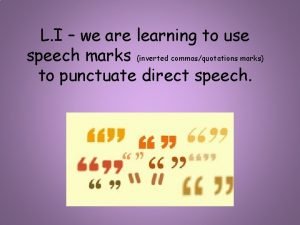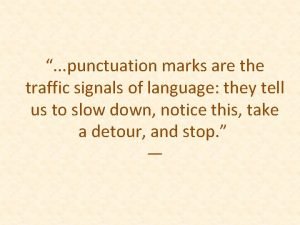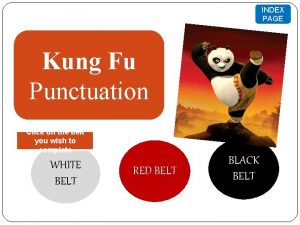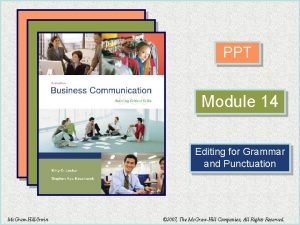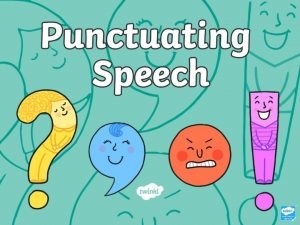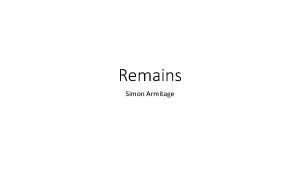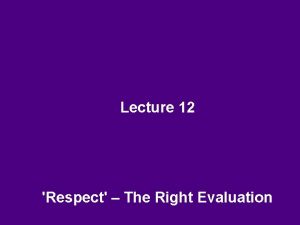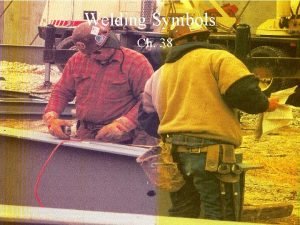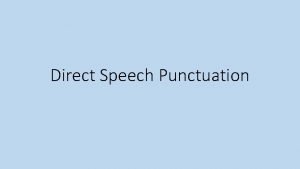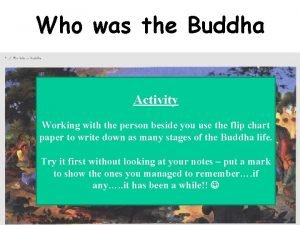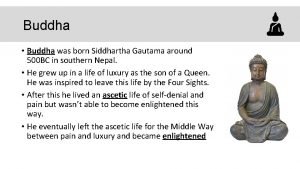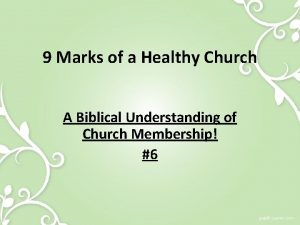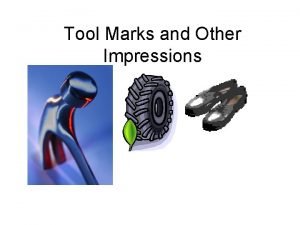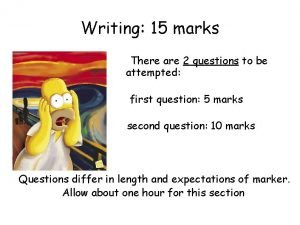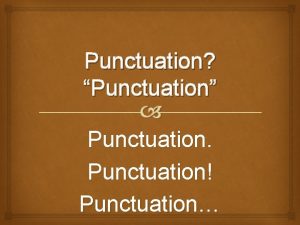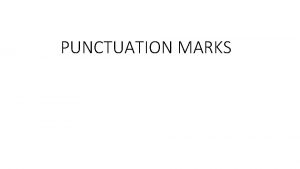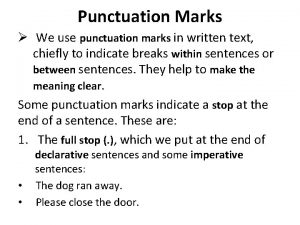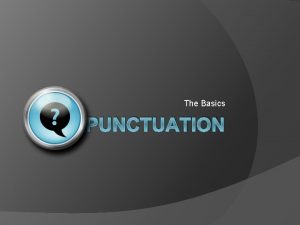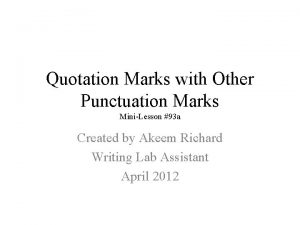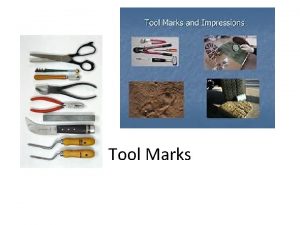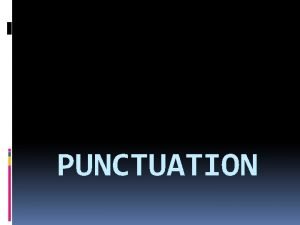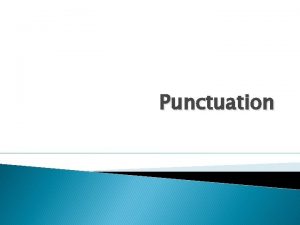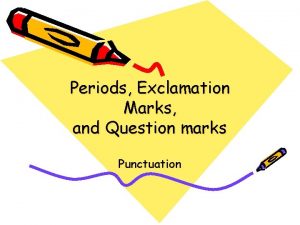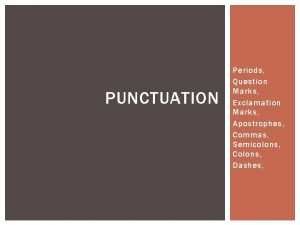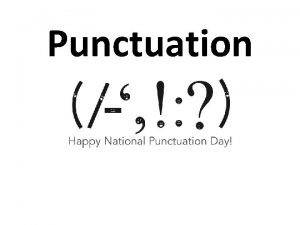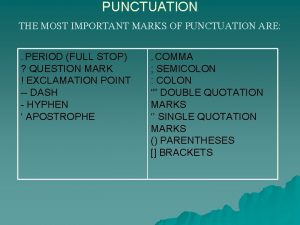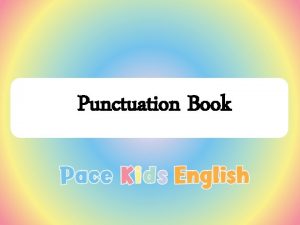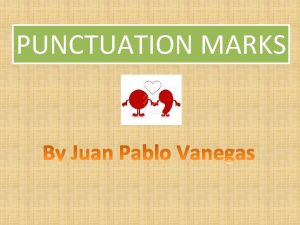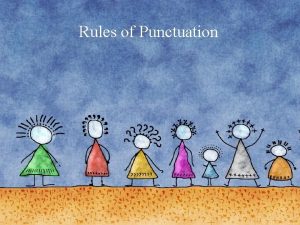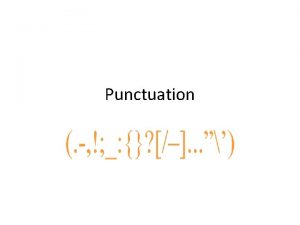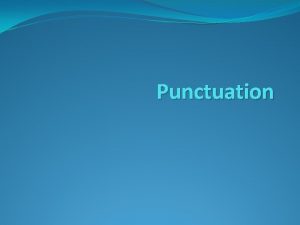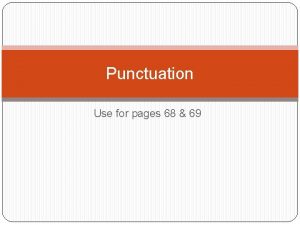Ch 27 Punctuation Other Marks of Punctuation See






















![[Brackets] … Not just for : ] • Used to enclose an explanation within [Brackets] … Not just for : ] • Used to enclose an explanation within](https://slidetodoc.com/presentation_image_h/b1971054861ea0569ae2e7829b5e8b9a/image-23.jpg)

- Slides: 24

Ch. 27 Punctuation Other Marks of Punctuation

See what you remember… • The first Alaskans most likely traveled to North America from Asia around twenty thousand years ago they may have been following caribou herds. • The new republic at once began increasing production and distribution of goods futhermore, it also appealed to other nations for financial assistance.

Semicolons • KEY CONCEPT: Use a semicolon between independent clauses that are closely related in thought and are NOT joined by a coordinating conjunction. • New candidates will run for president in 2016; all of them are currently in the news.

Semicolons • KEY CONCEPT: Use a semicolon between independent clauses joined by a conjunctive adverb or a transitional expression. • Some people believe that summer cannot come soon enough; however, they fail to realize that the Winter Olympics are very exciting.

Commonly used…(p. 851) Conjunctive Adverbs Transitional Expressions • • • • Accordingly Besides Consequently Furthermore However Otherwise Nevertheless Therefore As a result For example For instance In fact On the contrary That is

Semicolons • KEY CONCEPT: Semicolons are used before a coordinating conjunction when the independent clauses contain commas. • Also, when the items in a series contain commas. • My favorite events are figure skating, downhill skiing, luge, and bobsled; but, I don’t care to watch cross-country skiing or speed skating.

Colons: to “note what follows” • Before a list of items, especially after expressions like as follows, the following ▫ My Christmas list includes the following: Beats, Justin Bieber tickets, and a puppy. • Do not use a colon before a list that serves as an object of a preposition or complement ▫ The concert included performances by *NSYNC, the Backstreet Boys, and Britney Spears.

Colons: to “note what follows” • Before a long, formal statement or quotation • Between independent clauses when the second clause explains or restates the idea of the first ▫ Those running shoes are the best kind: purple and will last 500 miles. They are

Colons: Conventional situations • Between the hour and the minute in time ▫ 9: 30 a. m. 12: 00 noon 8: 00 p. m. • Between Biblical chapters and verses ▫ John 3: 16 Proverbs 3: 3 • Between titles and subtitles ▫ Frankenstein: The Modern Prometheus ▫ CSI: Crime Scene Investigation • After the salutation of a business letter ▫ To Whom It May Concern:

Practice • Page 852– Exercise 1 (odds only) • Page 854 – Exercise 2 (odds only) • Page 855 – Review A (All of them…) ▫ You will turn this in after a brief reflection!

Semicolons and Colons Practice • On a sheet of paper to be turned in… • Page 855 – Review A ▫ Semicolons and colons review ▫ Just write the word before the punctuation • After checking your answers, self-assess your ability to properly place semicolons and colons in sentences. ▫ Also– what questions do you have? ?

Italics vs. Quotation Marks ITALICS (underlining) • • • Books Plays Long Poems Periodicals Works of Art Films Radio/TV Series Long Musical Works Video & Computer Games Comic Strips QUOTATION MARKS • Titles/Subtitles of short stories • Short poems • Essays • Articles • Parts of songs • Episode titles (TV/Radio) • Chapters/parts of books

In addition… ITALICS (underlining) QUOTATION MARKS • • • Trains – Orient Express Ships - Titanic Aircraft – Air Force One Spacecraft – Challenger Words, letters, symbols referred to as such • Foreign words not translated to English Slang words Invented words Technical terms Dictionary definitions Any expressions unusual to English • Direct quotations

Direct Quotations • Use “…” to enclose EXACT words from a speaker or text • Generally begins with a CAPITAL letter ▫ Unless writing only PART of the quoted sentence �The speaker stated that the corpse was “a vile thing. ” ▫ Unless a quoted sentence is interrupted, the 2 nd part is lowercase �“Please read through chapter 13, ” explained Mrs. Krabill, “and we will have a discussion tomorrow. ” • Set off from rest of sentence with a comma, question mark, or exclamation. NOT A PERIOD!

Direct Quotations • Other punctuation rules for direct quotes ▫ Commas and periods are placed INSIDE closing quotes ▫ Semicolons and colons are placed OUTSIDE closing quotes ▫ Question marks and exclamation points are dependent on if they are part of the quote or not �My mom asked me, “Are you getting up today? ” �Did MLK, Jr. , say, “I have a dream”?

Direct Quotations • Dialogue: direct quotes between two or more people = change paragraphs for each new speaker • When direct quote is more than one paragraph, use a quote at the beginning of each AND at the end of the whole thing. ▫ Examples – pg. 862 • Use single quotes for a quote in a quote ▫ The teacher said, “Please tell me what Victor meant when he said, ‘I felt the bitterness of disappointment’. ”

Practice! • Page 858, Exercise 3 (odds only) • Page 864, Exercise 4 (odds only) ▫ You will have to add more punctuation than just quotation marks in this part!

Hyphens • To divide a word at the end of a line ▫ Do NOT divide a one-syllable word ▫ Divide a word only between syllables �Some-times ▫ Divide an already hyphenated word at the hyphen �Self-defense ▫ Do NOT divide words so that only 1 letter stands alone

Hyphens: Compound Words • Twenty-one to ninety-nine • Two-thirds majority (when used as modifier) • Prefixes and suffixes ▫ All-around president-elect Ex-boyfriend ▫ gluten-free non-smoking ▫ Great-grandmother mid-life pro-life • Compound adjective preceding the noun ▫ A well-rehearsed musical

Dashes • Gives a sharp separation within a sentence ▫ More definitive than commas or parentheses • To indicate an abrupt break in thought ▫ The party—I’m sorry I didn’t tell you earlier—was moved to next week. • To mean namely, that is, or in other words to introduce an explanation ▫ The weather has been unseasonable warm—in the mid-seventies—all October.

(Parentheses) • To enclose informative or explanatory material of MINOR IMPORTANCE ▫ Sentence that falls within another sentence �Does not begin with a capital letter �Should not end with a period, but may have a question mark or exclamation point �Paris, France (see the map on page 8) is lovely this time of year. ▫ Sentence that stands by itself �Should begin with a capital; end with proper punctuation �Mrs. Krabill would like to go to Paris. (Should we tell Mr. Krabill? )

(Parentheses) • Also used to enclose dates of people’s births and deaths ▫ Abraham Lincoln (1809 -1865) was a key figure during the Civil War.
![Brackets Not just for Used to enclose an explanation within [Brackets] … Not just for : ] • Used to enclose an explanation within](https://slidetodoc.com/presentation_image_h/b1971054861ea0569ae2e7829b5e8b9a/image-23.jpg)
[Brackets] … Not just for : ] • Used to enclose an explanation within quoted material • Similar to single quotes = quote in a quote • Brackets are parentheticals within quotes or parentheticals • Mostly in informational texts!

Practice! • Page 876 – Exercise 8 – #1 -10 • Page 880 – Exercise 9 - #1 -5
 A sentence with an exclamation mark
A sentence with an exclamation mark Put the correct punctuation marks in these sentences
Put the correct punctuation marks in these sentences Punctuation marks are like traffic signs. this sentence is
Punctuation marks are like traffic signs. this sentence is Kung fu punctuation speech marks
Kung fu punctuation speech marks Punctuation marks make meaning clear.
Punctuation marks make meaning clear. Put the correct punctuation marks in these sentences
Put the correct punctuation marks in these sentences Index of kung fu panda
Index of kung fu panda 14 punctuation marks ppt
14 punctuation marks ppt Punctuation
Punctuation How to use punctuation in quotes
How to use punctuation in quotes Remains annotations
Remains annotations Over evaluation leads to
Over evaluation leads to Tosses his guts analysis
Tosses his guts analysis Self-initiated other-repair
Self-initiated other-repair Weld all around
Weld all around Direct speech punctuation
Direct speech punctuation Ac marks
Ac marks Skhandas
Skhandas Types of buddhism
Types of buddhism If stick is coded as rshbj then reply is coded as
If stick is coded as rshbj then reply is coded as Quotation marks
Quotation marks Three quotation marks
Three quotation marks 9 marks of a healthy church
9 marks of a healthy church First impressions four marks
First impressions four marks How to write 15 marks answer
How to write 15 marks answer

